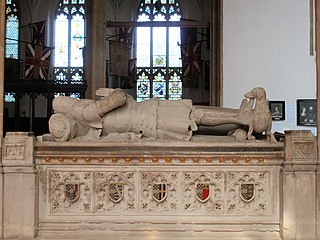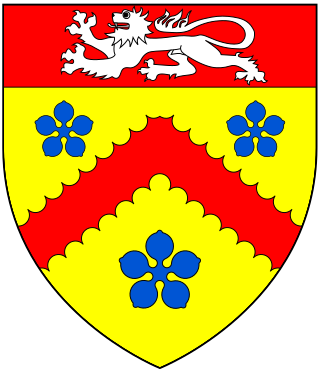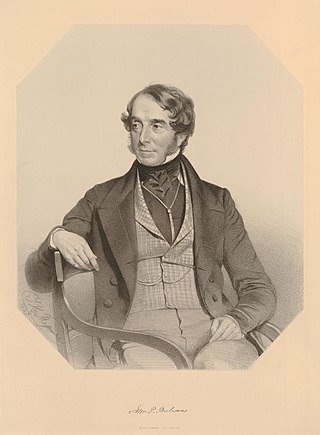Related Research Articles

Sir Robert Drury (1456–1536) was an English knight, Lord of the Manor of Hawstead, Suffolk, and Knight of the Body to Kings Henry VII and Henry VIII. As a politician he was Knight of the Shire for Suffolk, Speaker of the House of Commons, and Privy Councillor. He was also a barrister-at-law. His London townhouse was on the site of today's Drury Lane.
Robert Lee, 4th Earl of Lichfield (1706–1776) was an English politician and peer, the last of the Earls of Lichfield.
The Blois family have been substantial landowners in Suffolk for several centuries. Until recently the family home was at Cockfield Hall in Yoxford, Suffolk, a Grade 1 listed private house standing in 40 acres (160,000 m2) of historic parkland.
Three baronetcies were created for persons with the surname D'Oyly, two in the Baronetage of England and one in the Baronetage of the United Kingdom. One creation is extant as of 2008.

There have been three baronetcies created for persons with the surname Cooke, two in the Baronetage of England and one in the Baronetage of Ireland. One creation is extant as of 2013.
Fleetwood is an Anglo-Swedish baronial family. The lineage was introduced with number 49 in the House of Nobility, also known as the Riddarhuset.

Sir Nicholas Bacon, 1st Baronet, of Redgrave, Suffolk, English Member of Parliament. In 1611 he became the first man to be made a baronet. Bacon would serve on many commissions. The Privy Council constantly called upon him to conduct inquiries. He was a puritan leader in Suffolk. The power and prestige of the puritan ministries in many areas of the country owed their power to Bacon. Sir Nicholas Bacon was considered a good Christian by his contemporaries. Especially his chaplain, Robert Allen. Robert Allen stated that Sir Bacon's wife was dedicated to "God's holy religion and worship by every good and Christian means in the sight of men."

Sir William Spring, 1st Baronet was an English landowner and politician. During the English Civil War, he was one of the leading Parliamentarian officials in East Anglia. He was the Member of Parliament for Bury St Edmunds before being removed during Pride's Purge in 1648, but was returned to the House of Commons as the MP for Suffolk shortly before his death in 1654.

The Spring family is a Suffolk gentry family that has been involved in the politics and economy of East Anglia since the 15th century, as well as holding large estates in Ireland from the 16th century.

Sir Thomas Kitson was a wealthy English merchant, Sheriff of London, and builder of Hengrave Hall in Suffolk.
Sir John Spring, of Lavenham, Buxhall, Hitcham, and Cockfield, Suffolk, was an English merchant and politician.

Sir John Peter Boileau, 1st Baronet FRS, DL, JP was a British baronet and archaeologist.
Sir George Downing, 2nd Baronet was a British civil servant. He was the son and heir of Sir George Downing, 1st Baronet, for whom Downing Street is named.

Sir Anthony Cope, 1st Baronet of Hanwell in Oxfordshire, was an English Puritan Member of Parliament.
Sir Thomas Hatton, 1st Baronet was an English politician who sat in the House of Commons of England variously between 1621 and 1640.

Thomas Spring of Lavenham in Suffolk, was an English cloth merchant. He consolidated his father's business to become one of the most successful in the booming wool trade of the period and was one of the richest men in England. He has been described as the most important figure of the early Tudor cloth industry.

Sir Charles Morrison was an English politician in the reign of Queen Elizabeth I and heir to the Estate of Cassiobury in Watford, Hertfordshire. He sat in the Parliament of England as MP for Tavistock.

Sir Jermyn Davers, 4th Baronet, of Rougham and Rushbrooke, Suffolk, was an English landowner and Tory politician who sat in the House of Commons from 1722 to 1743.
Sir Thomas Southwell, 1st Baronet, of Castle Mattress was a high sheriff of County Kerry under the Protectorate.

Thomas Peyton (1418–1484) of Isleham, Cambridgeshire, was twice Sheriff of Cambridgeshire and Huntingdonshire, in 1443 and 1453. He rebuilt the church of St Andrew's in Isleham, in the chancel of which survives his monumental brass. He is depicted in a 1485 stained glass window in Long Melford Church, Suffolk, where he displays on his surcoat the Peyton arms: Sable, a cross engrailed or a mullet in the first quarter argent.
References
- Betham, William (1803). The Baronetage of England. Vol. III. London: W.S. Betham. p. 60. Retrieved 26 April 2013.
- Burke, John; Burke, John Bernard (1838). A Genealogical and Heraldic History of the Extinct and Dormant Baronetcies of England. London: Scott, Webster and Geary. p. 510. Retrieved 25 April 2013.
- Howard, Joseph Jackson, ed. (1866). The Visitation of Suffolk. Vol. I. London: Whittaker and Co. pp. 165–206. Retrieved 26 April 2013.
- "Pakenham – Village of Two Mills" . Retrieved 1 April 2013.